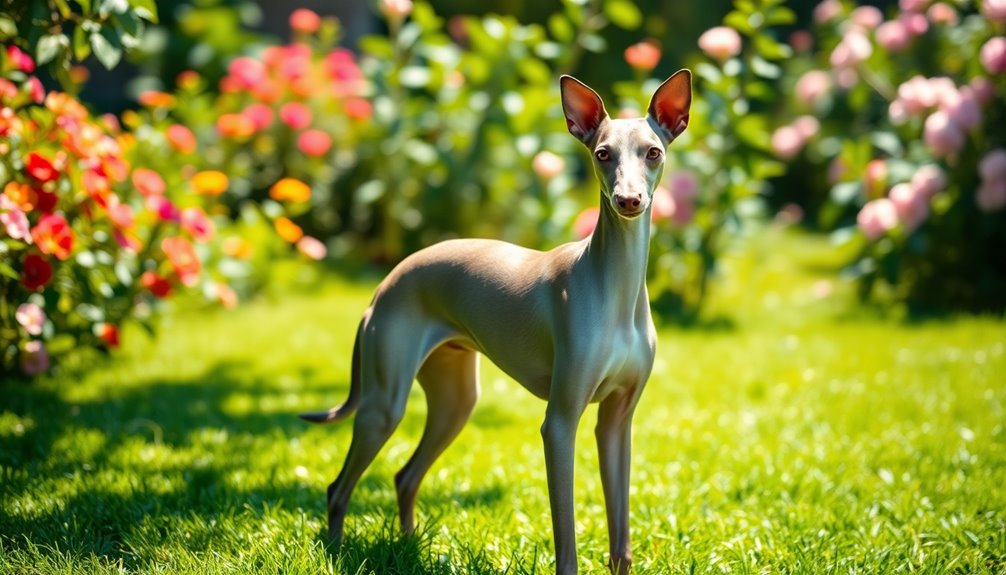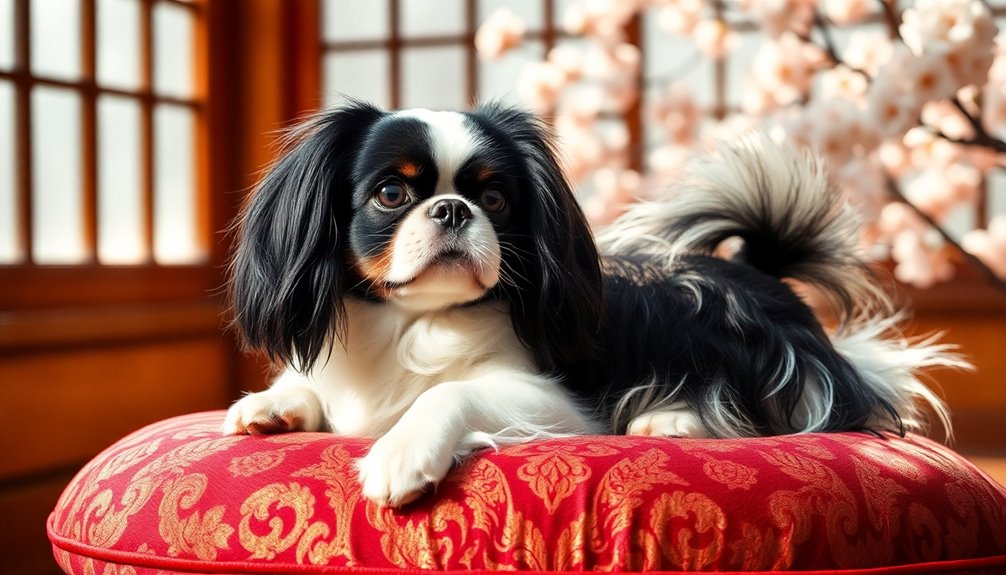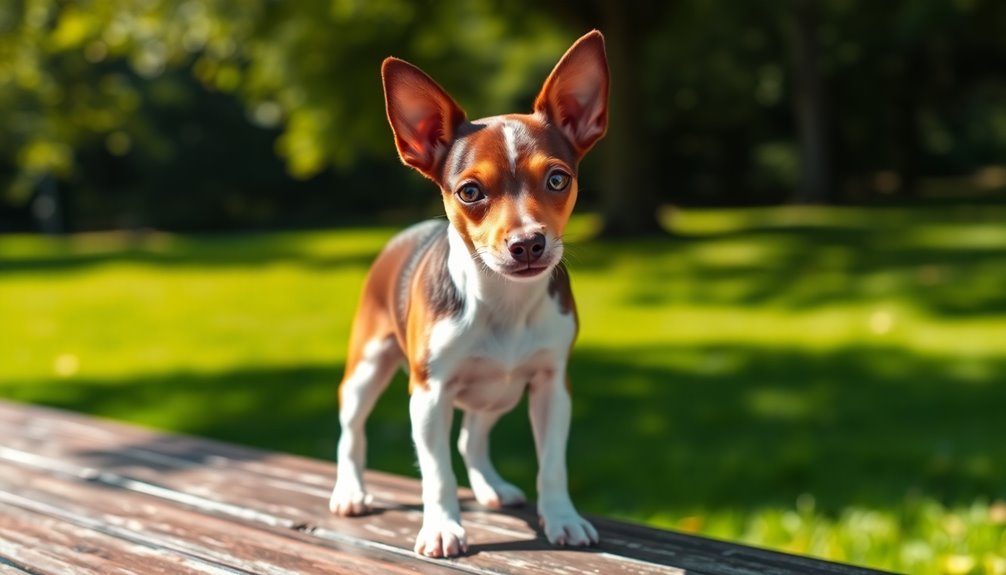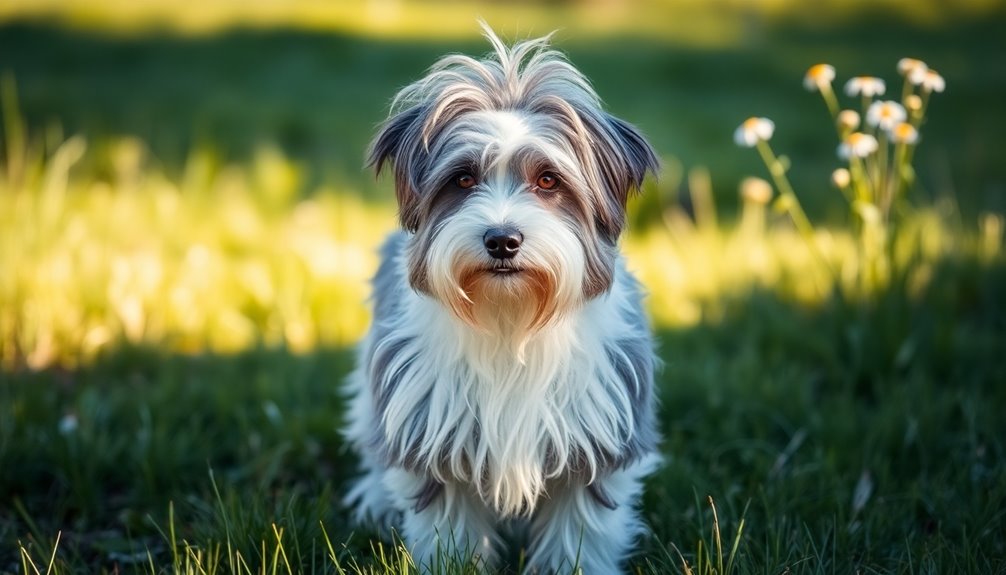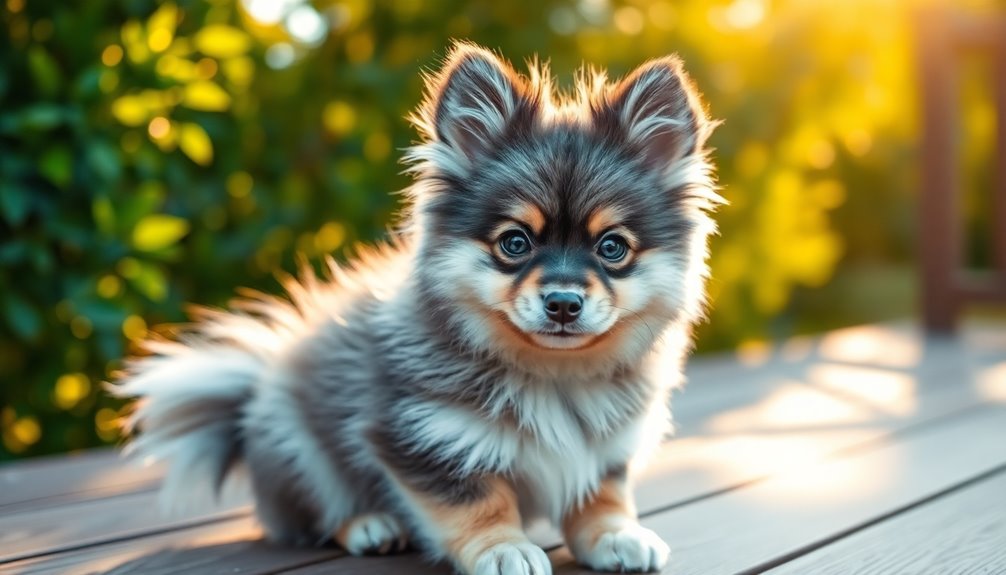The Italian Greyhound is a sleek and elegant companion that you'll absolutely adore. These affectionate dogs are playful and thrive on companionship, making them ideal for active families or individuals. With a remarkable speed of up to 30 mph, they bring energy and excitement to your life. Their slender build and graceful movements will capture your heart. However, they do need daily exercise and companionship to stay happy and healthy. Gentle with children and adaptable to living environments, they're perfect for both apartments and homes. Discover more about their unique qualities and the care they require to thrive!
Key Takeaways
- Italian Greyhounds are affectionate companions, forming strong bonds with family members and thriving in calm environments.
- Their slender, athletic build allows for agility and grace, making them a visually striking breed.
- Playful and energetic, they can reach speeds of 25-30 mph, requiring regular exercise for vitality.
- They adapt well to urban living, suitable for apartments with daily walks and playtime.
- Italian Greyhounds require consistent training and socialization, responding best to positive reinforcement techniques.
Introduction
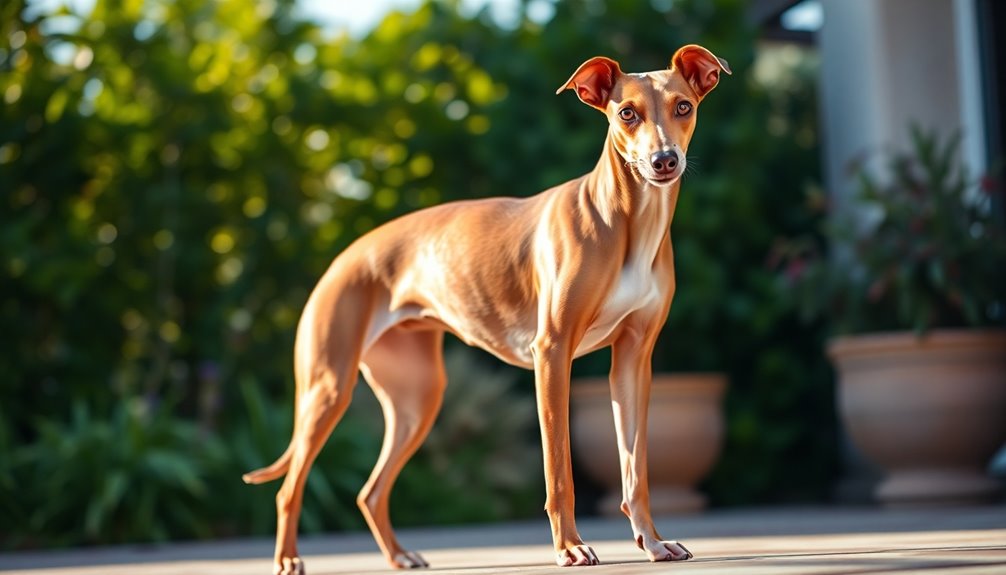
Italian Greyhounds are often known for their affectionate nature and sleek appearance, making them ideal companions for many dog lovers. Standing between 12 to 15 inches tall and weighing 6 to 14 pounds, these slender, fine-boned dogs capture hearts with their graceful long necks and arched backs. Their short, smooth, and glossy coats come in various colors, such as gray, black, and fawn, adding to their elegance.
What sets them apart is their loyal and loving temperament. You'll find them constantly underfoot, eager to be near you. Their playful spirit lasts well beyond puppyhood, ensuring you'll never have a dull moment. However, they can be sensitive and don't like being left alone for too long, so companionship is key. Additionally, they are known for their high prey drive, so providing a secure outdoor environment is essential.
While they're generally quiet, Italian Greyhounds require regular exercise and mental stimulation. Be prepared for some training challenges, as their intelligence can come with a side of stubbornness. Positive reinforcement works wonders, so consistency in training is vital.
Just remember, they're escape artists, so keeping them secure is essential. With the right care and attention, these dogs will be devoted and elegant companions in your life.
History and Origin
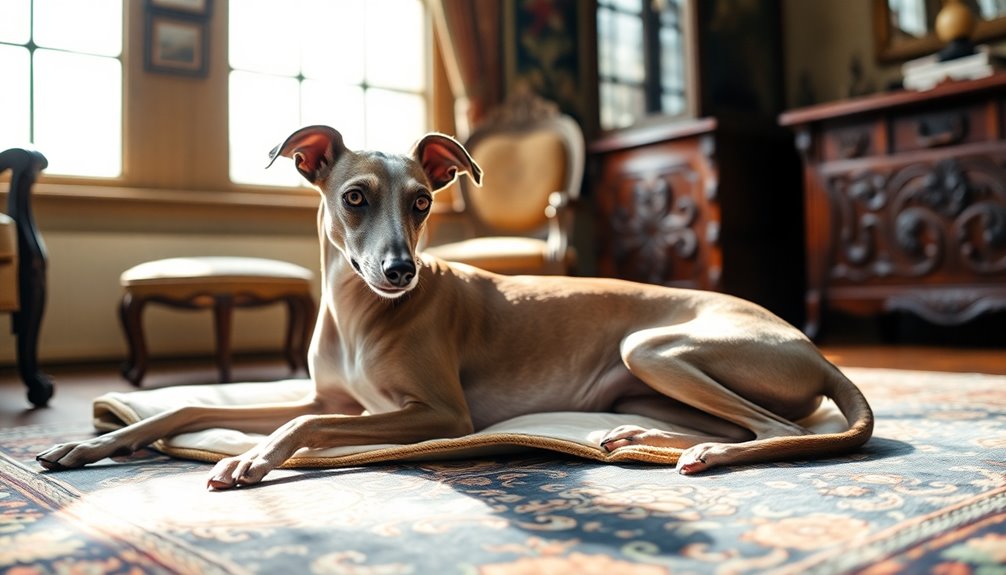
The Italian Greyhound has roots that stretch back over 2000 years to regions now known as Greece and Turkey. Known as a sighthound, this breed was originally used for hunting small game, showcasing its agility and speed. You'll find its historical significance reflected in ancient art and the companionship it provided to nobility throughout the ages. Notable owners include Frederick II, Catherine the Great, and Queen Victoria, highlighting its popularity among the elite.
Where and when the breed originated
Originating over 2000 years ago in the Mediterranean basin, the Italian Greyhound has roots that trace back to regions now known as Greece and Turkey.
You'll find evidence of their early existence in ancient decorative arts and archaeological discoveries of small greyhound skeletons. These dogs served as companions to royal families, aristocrats, and generals, underscoring their significance in history. In fact, many were mummified and buried with their owners, highlighting their cherished status.
By the Middle Ages, the breed had spread throughout southern Europe, gaining immense popularity, especially in Italy during the 16th century, which is how it earned its name. Their elegant stature and affectionate nature made them highly sought after as pets in royal households.
The Italian Greyhound captured the hearts of European royalty, including notable figures like James I's consort Anne of Denmark and Catherine the Great of Russia. Artists of the Renaissance, such as Giotto and Carpaccio, frequently depicted these elegant dogs in their paintings, showcasing their beauty and sweet disposition.
With such a rich history, the Italian Greyhound stands as a testament to companionship, elegance, and enduring charm, making it a beloved pet even today.
Sighthound for Small Game
Throughout history, the Italian Greyhound's elegance and charm also made it a formidable sighthound for hunting small game. Originally bred not as a scaled-down Greyhound but through selective breeding for smaller size, these dogs quickly became favorites among royal families and aristocrats. Their high prey drive and instinct to chase made them excellent hunters, particularly for small animals.
Physically, their long, narrow heads and fine muzzles, combined with large, expressive eyes, enhance their sight hunting abilities. With short, silky coats and a lean body structure, they minimize drag, ensuring speed and agility. Their long necks and legs provide aerodynamic perfection, crucial for swift pursuits. Additionally, their graceful and distinguished appearance is a hallmark of the breed, further endearing them to dog lovers.
Behaviorally, Italian Greyhounds possess a strong instinct to chase small, moving creatures. They're athletic and capable of impressive speeds, though their independent nature often means they don't require much human direction. However, their stubbornness can pose challenges, necessitating consistent, reward-based training.
In modern settings, if you allow your Italian Greyhound to roam freely, early anti-hunting training is essential. Their strong prey drive means they may chase cars or other dangers, highlighting the need for secure, fenced areas and effective recall training before off-leash activities.
Physical Characteristics
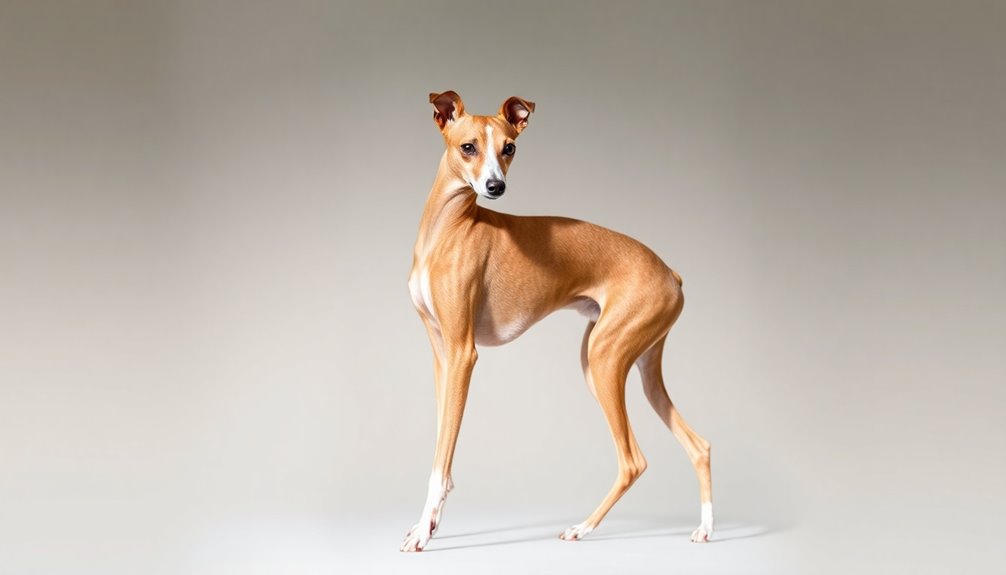
When you think of the Italian Greyhound, envision a slender, athletic dog standing 13 to 15 inches tall and weighing between 7 to 14 pounds. Their short, silky coat comes in a range of beautiful colors, adding to their elegance. With a long, graceful neck and a fine-boned structure, these dogs exude charm and sophistication. These dogs are known for their high energy level, requiring regular activity to maintain their health and happiness.
Size, weight, and coat details
Italian Greyhounds typically stand between 13 to 15 inches tall at the shoulder, making them a compact and elegant breed. By around 10 months, they reach their full height, although it may take up to 1.5 years for them to fully mature physically. Full size is generally achieved by 8 months, which is an important milestone in their growth.
Both males and females generally share the same height, but you might find some that are slightly smaller or larger than average.
When it comes to weight, adult Italian Greyhounds usually weigh between 3 to 6 kilograms (7 to 14 pounds), with the ideal weight being around 5 to 6 kilograms. Some smaller individuals may weigh about 2 kilograms, while larger ones can tip the scales at up to 9 kilograms. Keeping your Italian Greyhound at a healthy weight is essential, as even a few extra pounds can lead to obesity.
Their coat comes in a stunning array of colors, including Sable, Red, and Black, as well as various patterns like Solid, Irish, and Pied. Each color can showcase unique features, but you won't find brindle in this breed. As they age, you might notice some grey hairs, particularly on white-faced dogs.
Long, Slender Neck Elegance
Emphasizing elegance, the Italian Greyhound's long, slender neck is one of its most striking physical characteristics. This gracefully arched neck closely resembles that of its larger cousin, the Greyhound, but it's even more slender in proportion. It widens gradually into the shoulder, contributing significantly to the dog's overall grace and poise. You'll notice how free it's from throatiness, enhancing its refined appearance.
The narrow and long head tapers delicately to the nose, with a skull that's long and almost flat, featuring just a slight suggestion of a stop. Its long, fine muzzle adds to the sleek look, while the body remains medium in length and short coupled. The back is elegantly curved, rising high at the withers and gently dropping at the hindquarters, with the highest point of the curve at the loin. This graceful structure is essential for high stepping movement, which is characteristic of the breed.
Small, fine-textured ears are typically folded back, adding to the Italian Greyhound's charm. When alerted, these ears carry at right angles to the head.
Temperament and Personality
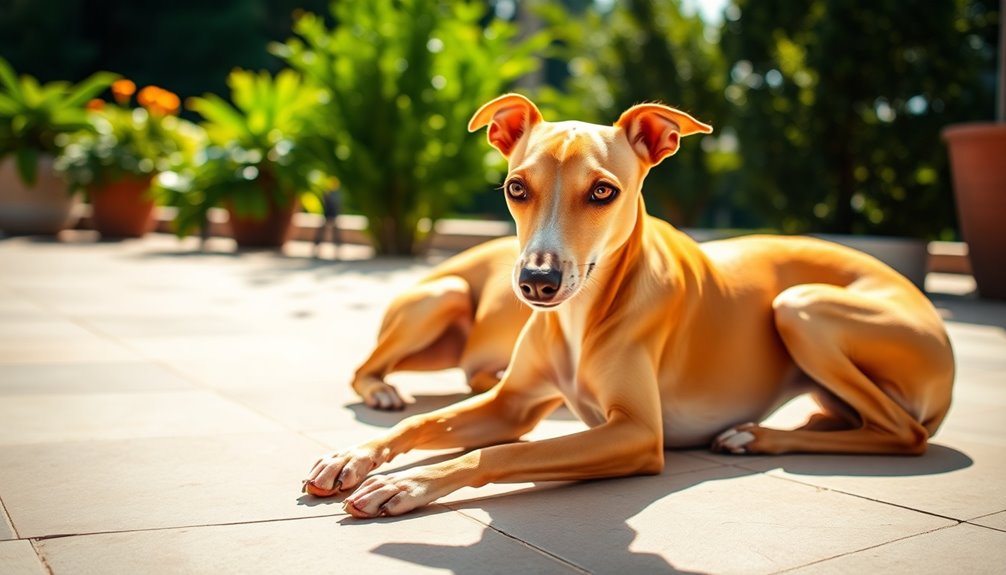
When you bring an Italian Greyhound into your home, you'll quickly notice their playful and spirited demeanor. These dogs aren't just great companions for individuals; they also fit well into families and can coexist happily with other pets. Their energetic nature and affectionate personality make them a delightful addition to any household. To keep up with their high-energy nature, regular exercise and mental stimulation are essential for their well-being.
Playful and Spirited Demeanor
With a playful spirit that endures throughout their lives, Italian Greyhounds are a bundle of energy and joy. These dogs thrive on activity, often engaging in playful antics like the famous 'zoomies,' where they dash around at impressive speeds of 25–30 mph. Their agility and zest for life make them perfect companions for active individuals or families.
Affectionate and sociable, Italian Greyhounds bond deeply with their owners. You'll find them constantly seeking your company, often curling up in your lap or climbing into your bed. Their gentle nature makes them endearing shadows in your home, always eager to be by your side. Additionally, they are known for their sensitive to emotions nature, which means they flourish in calm environments where they feel secure.
However, their sensitivity also plays a role in their spirited demeanor. They're perceptive to your emotions and can become unsettled by loud noises or rough handling. Creating a calm environment is key to their happiness.
While they may be intelligent, their stubborn streak can make training a challenge. Utilizing positive reinforcement and keeping training sessions short and consistent will yield the best results.
Suitability for families, individuals, or other pets
Italian Greyhounds make excellent companions for families, individuals, and even other pets, thanks to their affectionate and adaptable nature.
They're gentle and patient with children, but it's essential to supervise interactions closely to prevent any accidental injuries. Their loyalty shines through as they form strong bonds with family members, thriving in various living situations, including apartments. Just remember, they need regular exercise and secure spaces to run freely. Additionally, their muscular yet slender build allows them to be agile and graceful, making them a joy to watch as they move. Setting boundaries in their daily routine can help maintain a balanced lifestyle for both pets and owners.
When it comes to other pets, Italian Greyhounds generally get along well with cats and smaller dogs. Their friendly disposition helps them adapt smoothly in multi-pet households, provided you introduce them properly.
Be cautious, though, as some may not tolerate larger dogs or rambunctious puppies.
For individuals or first-time owners, these dogs are a fantastic choice. They require minimal grooming and are relatively low-maintenance, perfect for seniors or busy lifestyles.
However, they do crave companionship and dislike being left alone for long hours. Sensitive to cold, they need extra warmth during chilly months.
With their loving nature and quiet demeanor, Italian Greyhounds can be a wonderful addition to any home.
Health and Lifespan
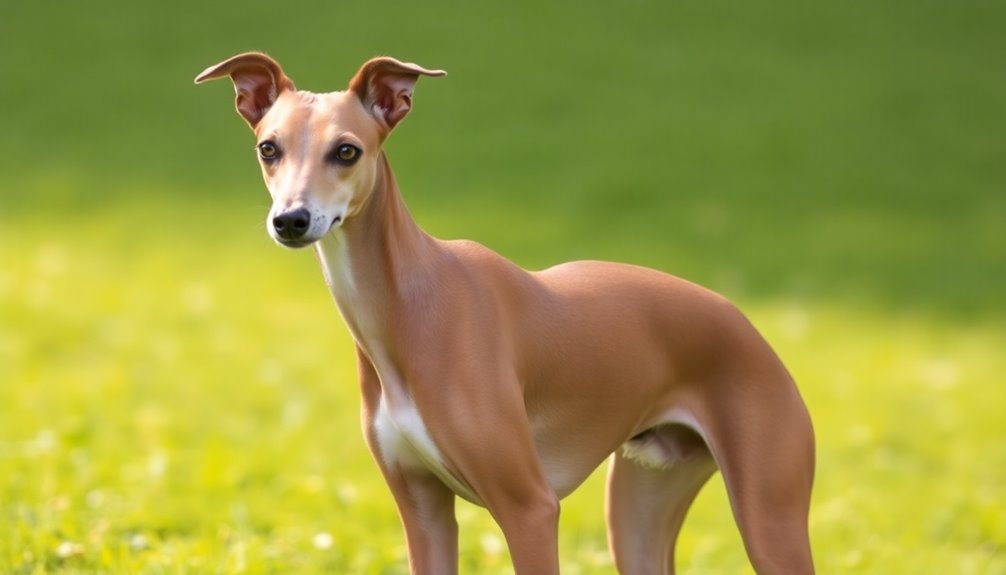
When it comes to your Italian Greyhound's health, knowing their typical lifespan of 13-15 years can help you plan for their care. They can face some common health issues like progressive retinal atrophy and luxating patellas, so staying informed is crucial. To keep your pup happy and healthy, focus on regular exercise, a balanced diet, and routine veterinary check-ups. It's also important to be aware that they are prone to broken bones due to their slight frames, making safe environments essential for their playtime.
Typical lifespan of the breed
The typical lifespan of an Italian Greyhound ranges from 12 to 14 years, though some may live up to 16 or even 18 years with proper care. Your dog's longevity can significantly depend on factors like health, living conditions, and responsible ownership. Keeping a close eye on their well-being and making regular vet visits can help ensure they enjoy a longer life. Accidents, particularly those involving their fragile bones, can lead to premature death. So, it's essential to handle them gently and avoid hazardous situations. Additionally, climate conditions play a role; extreme temperatures can negatively impact their health. To maintain their vitality, ensure your Italian Greyhound gets at least 30 minutes of exercise daily—this includes walks and playtime. Regular health screenings can help identify and mitigate potential health issues, so providing that's crucial. They thrive in a safe and cozy environment, so providing that's crucial.
Common health concerns or genetic predispositions
While Italian Greyhounds can enjoy a long lifespan with proper care, they're also susceptible to several health concerns and genetic predispositions that owners should be aware of. One major issue is their fragile skeletal structure, which makes them prone to fractures and conditions like luxating patella and hip dysplasia. These can lead to pain, mobility issues, and arthritis as they age. Regular veterinary check-ups are essential for early detection of these conditions.
In addition to skeletal problems, eye and ear issues are common. Progressive retinal atrophy can lead to blindness, while cataracts and glaucoma may require surgical intervention. Ear allergies and parasitic infections like ear mites can also cause discomfort.
Skin and coat health is another concern. Many Italian Greyhounds suffer from color dilution alopecia, leading to thinning fur, and they're at risk for skin tumors and mange.
Internal health issues include hypothyroidism, dental disease, and diabetes, which require regular monitoring and management.
Being aware of these potential health issues can help you take proactive steps to ensure your Italian Greyhound remains happy and healthy throughout their life. Regular veterinary check-ups and attentive care can make a significant difference in their overall well-being.
Tips for maintaining health and wellness
Maintaining the health and wellness of your Italian Greyhound is essential for ensuring a long and happy life. Start with a balanced diet; provide high-quality food tailored to their needs. For seniors, consider moisture-rich meals like quality wet food or vet-approved home-cooked diets. Additionally, be aware that Italian Greyhounds have a history of being treasured companions, which can motivate owners to provide affectionate care to help maintain their happiness.
Don't forget to incorporate supplements such as omega-3s for skin and coat health. Avoid overfeeding to prevent obesity.
Regular exercise is crucial, too. Aim for one or two daily walks, along with indoor play sessions to release their high energy. If possible, let them run in a fenced-in area.
Remember, while Italian Greyhounds don't require as much exercise as larger breeds, they still need mental stimulation.
Grooming is straightforward with their low-maintenance coat, but brushing when dusty or shedding is helpful. Bathe them every few months, and trim their nails monthly.
Prioritize dental care by brushing their teeth multiple times a week.
Regular veterinary check-ups are vital for preventive care. Keep an eye on their weight, and consider sun protection with dog-safe sunscreen.
Finally, socialize your Italian Greyhound early on to foster a well-rounded personality and use positive training methods to strengthen your bond.
Care Requirements
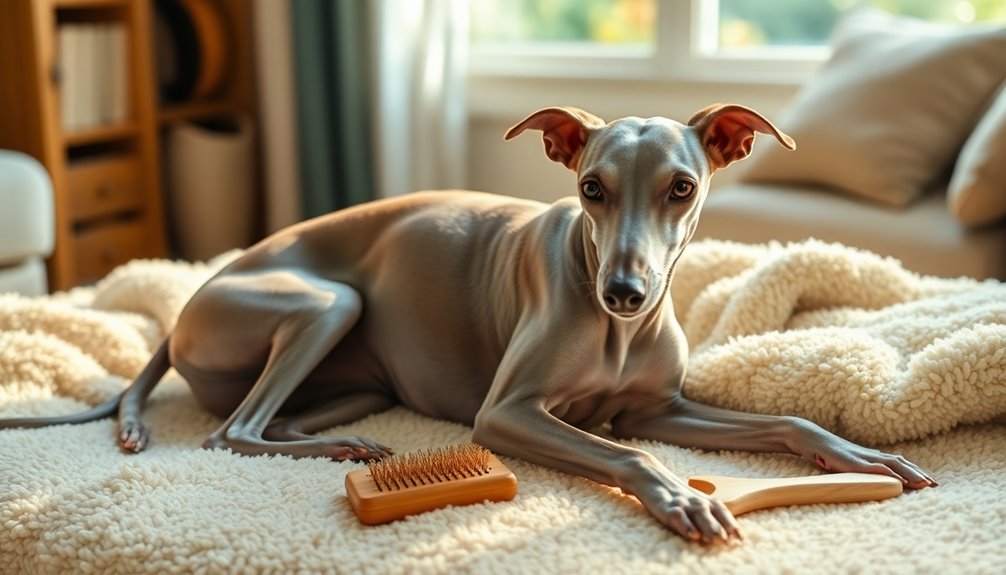
Caring for your Italian Greyhound means meeting their exercise needs while enjoying the benefits of minimal shedding.
You'll want to ensure they get about 45 minutes to an hour of physical activity each day, along with a balanced diet tailored to their specific requirements. Regular exercise is crucial to prevent destructive behavior that can arise from being under-exercised. Additionally, regular grooming can help manage their shedding significantly and keep their coat healthy.
Keeping an eye on their energy levels and dietary needs will help keep your furry friend happy and healthy.
Minimal Shedding Maintenance Required
The Italian Greyhound's short, satin-like coat requires minimal shedding maintenance, making grooming a breeze for owners. With their smooth coat, you'll notice that shedding is quite low, which means less time spent cleaning up fur around your home.
Weekly brushing with a rubber mitt or soft brush will help you remove any excess hair and keep their coat looking sleek. During heavier shedding seasons, consider using a pin rake to tackle trapped hair effectively. Additionally, it's important to perform daily check-ups to catch any health issues early on.
In addition to regular brushing, daily check-ups are essential for overall health. Inspect your dog's body for lumps or bumps, and keep an eye on their eyes to ensure they look normal.
Regular mouth checks can help you spot dental issues early, so make sure their teeth are clean and gums appear pink and healthy. Don't forget to check their ears for wax or signs of infection, and inspect their paws for any potential issues.
For dental care, brush their teeth daily using a canine toothbrush and toothpaste designed for dogs to prevent periodontal disease.
Finally, trim their nails weekly or bi-weekly to avoid discomfort and ensure they're comfortable while walking.
Exercise requirements and energy levels
Italian Greyhounds thrive on daily exercise to keep their minds and bodies healthy. They require a minimum of one walk per day lasting at least one hour, but ideally, two walks will enhance their physical and psychological well-being.
You can break exercise into multiple short walks or play sessions, and free-running in safe areas is essential. Just be cautious of busy roads and uneven ground to prevent injuries.
Physical activities should be age-appropriate, particularly for puppies, to protect their developing joints. Italian Greyhounds have high prey drives, so be prepared for the challenge of recall when they chase small animals. To promote their health, ensure they engage in regular exercise to prevent obesity and related health issues.
Engaging them in activities like fetch, agility training, or interactive play can be beneficial. Avoid excessive exercise on hard surfaces to prevent bone and joint injuries.
Feeding tips and diet recommendations
Providing your Italian Greyhound with a balanced diet is crucial for their overall health and well-being. Focus on high-quality animal-based protein sources like beef, chicken, and fish to fuel their energy needs. Incorporate essential fatty acids and omegas to support optimal health, along with small amounts of carbohydrates from vegetables and berries for fiber and antioxidants. A species-appropriate diet promotes overall health and happiness in dogs, making it an essential consideration for your Italian Greyhound. Additionally, understanding the Law of Attraction can help you create a positive environment for your pet, which can enhance their overall well-being.
For adult Italian Greyhounds, aim for two meals a day, while puppies need three to four small meals until they're six months old. Remember to avoid sudden diet changes to prevent digestive issues; introduce new food gradually. Adjust feeding amounts based on your dog's age, size, and activity level.
As your Italian Greyhound ages, nutritional needs will change. Puppies require nutrient-rich food for growth, while adults benefit from a balanced diet that may include omega-3 supplements for skin and coat health. Seniors should have fewer calories, focusing on digestibility and joint health.
Always choose balanced and complete dog food and avoid table scraps to prevent obesity.
Lastly, ensure your companion has unrestricted access to fresh, clean water at all times for proper hydration.
Training and Socialization
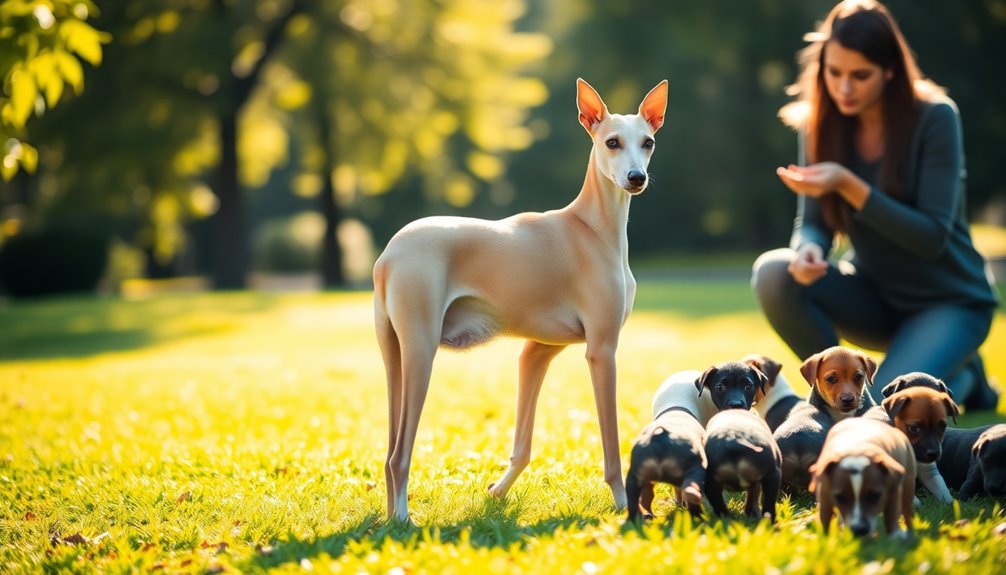
Training your Italian Greyhound requires patience, as they're moderately responsive to commands. When introducing them to new friends, take it slow to help prevent any anxiety. Consistent training methods will aid in reinforcing their learning and help them adjust better to new situations.
Moderately Responsive to Commands
When it comes to training an Italian Greyhound, you'll quickly notice that they're moderately responsive to commands, thanks to their unique blend of independence and intelligence. To make training effective, positive reinforcement is key. Techniques like clicker training, treats, and praise work wonders, but you should steer clear of punishment or harsh treatment since these dogs are sensitive.
You'll find that consistency and patience are crucial in overcoming their training challenges. Although they may not be the most biddable breed, short training sessions can keep them engaged and focused. Balancing their watchful nature with guided responses will help you harness their intelligence and tackle any stubbornness. Additionally, their high energy level means that incorporating regular exercise into their training routine can further enhance their responsiveness. Engaging in puppy training classes can also provide valuable socialization opportunities for your Italian Greyhound.
Also, specialized training activities, such as agility, can offer both mental and physical stimulation, keeping your Italian Greyhound happy and healthy.
Remember to address their moderate tendency to bark by rewarding quiet behavior and understanding their triggers. Your firm but gentle approach will correct undesired behaviors without causing fear.
With dedication and the right techniques, you'll foster a well-trained companion who responds to your commands while showcasing their elegant personality.
Gradual Introductions to New Friends
To ensure your Italian Greyhound grows into a well-adjusted adult, gradual introductions to new friends are essential. Start socializing your puppy between 8 to 12 weeks, after their vaccinations are effective. Expose them to a variety of people—different ages, genders, and ethnicities—to broaden their comfort zone.
Take them to diverse locations like PetSmart or outdoor cafes, and let them explore various surfaces, such as grass and tile.
Create a controlled environment where your puppy can interact without feeling overwhelmed. Encourage gentle approaches from strangers, especially children, and keep your pup under control. Be ready for accidents by carrying paper towels and bags, maintaining a positive atmosphere.
Using positive experiences during socialization can help your puppy develop confidence in new situations.
Use positive reinforcement techniques, like treats and praise, to encourage good behavior. Reward your puppy immediately after any slightly stressful situation to help them associate new experiences with positivity.
Engage in interactive play and provide mental stimulation through puzzle toys.
Separation Anxiety Tendencies
Separation anxiety can be a significant issue for Italian Greyhounds, given their strong attachment to their human companions. This anxiety manifests as destructive behavior, howling, or accidents in the house when they're left alone.
Since these dogs are bred as companions, they thrive on interaction and can easily develop behavioral issues if left isolated for too long. To prevent separation anxiety, focus on training and socialization. Start by crate training your Italian Greyhound, ensuring the crate is a safe and comfortable space. Gradually introduce the crate, rewarding calm behavior with treats and praise. A kennel must allow the dog to stand, turn, and lay down comfortably to promote a sense of security. It is also important to establish consistent routines to foster a sense of stability for your pet.
Consistency is key—stick to a routine for feeding and outdoor activities to help them feel secure.
Use positive reinforcement techniques during training sessions, avoiding harsh punishments that can instill fear. Engage your dog in stimulating activities like agility or scent work to keep their minds active, which can reduce anxiety.
Lastly, be mindful of your dog's need for companionship. Ensure they're not left alone for extended periods, as this can exacerbate their anxiety.
Ideal Living Environment
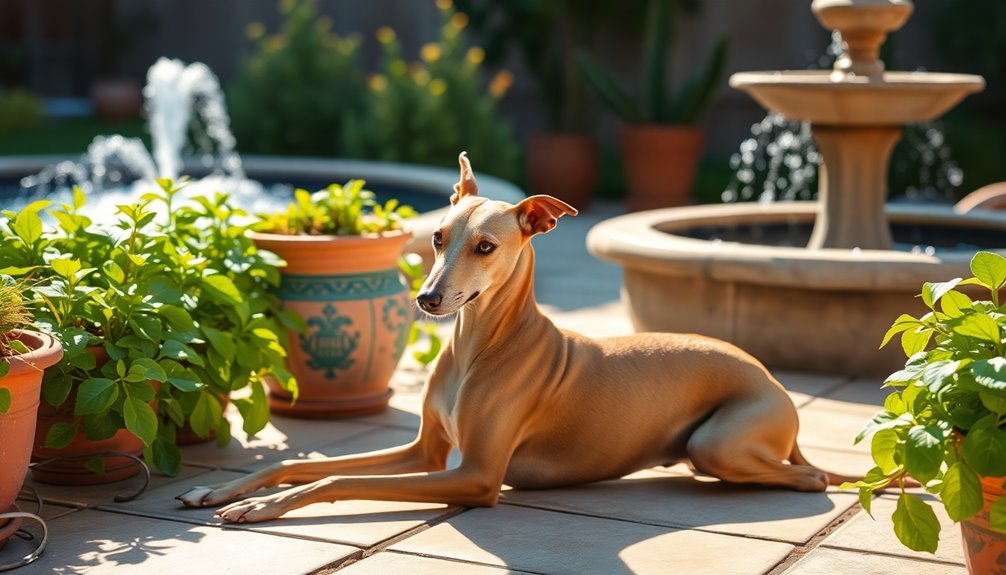
If you live in an urban apartment, you can still provide an ideal environment for your Italian Greyhound, as long as you ensure they get plenty of exercise. These dogs thrive in warm weather, so keeping them active outdoors during moderate temperatures is essential. Just remember to create safe spaces for play and be mindful of their sensitivity to extreme conditions. Additionally, it's important to note that Italian Greyhounds are moderately active and require regular exercise to maintain their health and happiness. Incorporating quick breakfast options can help you start your day with energy for those outdoor adventures.
Urban Apartment Living Ideal
An Italian Greyhound makes an excellent companion for urban apartment living, thanks to its small size and adaptable nature. Weighing between 3.6 to 4.5 kgs (8 to 10 lbs) and standing 32 to 38 cms (12½ to 15 ins) tall, these dogs thrive in smaller spaces, requiring minimal room to feel comfortable. A cozy apartment with a quiet retreat area suits them perfectly.
While they need regular exercise, you don't need a large yard. Daily walks and occasional runs in enclosed spaces meet their activity needs. Italian Greyhounds can sprint up to 25 miles per hour, displaying their graceful high-stepping gait. Their relatively quiet demeanor means they won't disrupt your neighbors, making them ideal for apartment living.
They're not prone to excessive barking and communicate with a unique sound known as "rooing" when they want attention. Additionally, their low energy indoors allows them to relax and lounge comfortably after playtime.
With a gentle temperament, they bond closely with family members and are great with kids and other pets. Early socialization helps them build confidence, ensuring they adapt well to urban environments.
Warm Weather Preference
Italian Greyhounds thrive in warm weather, making them ideal companions for those living in sunny climates. Their slim and elegant build, coupled with minimal body fat, helps them cool down effectively. With their short coats in light colors like tan, gray, cream, or brown, they can efficiently dissipate heat, while large ears assist in regulating body temperature. Additionally, they are known for their energetic disposition, which allows them to enjoy outdoor activities even in high temperatures. Emotional alignment is also important for their well-being, as it helps them adapt to their environment.
However, you'll need to be mindful of their sensitivity to heat. During warmer days, limit their exposure to direct sunlight for more than 30 minutes, especially when temperatures exceed 80°F (27°C). Providing access to cool water is essential to prevent overheating, and regular breaks during playtime are necessary to keep their heart rate in check.
To ensure their comfort, consider using cooling mats or wet towels, and treat them to frozen snacks. If you notice excessive panting, disorientation, or a body temperature above 103°F (39.5°C), take immediate action by moving them to a cooler area and offering cold water.
Consulting a vet is crucial if symptoms persist. With the right precautions, your Italian Greyhound can enjoy the warm weather to the fullest.
Speedy Sprinters on the Track

When you think of Italian Greyhounds, speed and sensitivity to temperature changes come to mind.
These elegant sprinters not only showcase their agility on the track but also require careful consideration of their environment to perform their best. Their impressive 25 mph speed is typically displayed when chasing prey, underscoring their athletic nature. Interestingly, their grace has even made them a favorite subject in Renaissance artwork, highlighting their beauty and athleticism.
Sensitive to Temperature Changes
Speeding across the track, these agile companions showcase their impressive athleticism, but their sensitivity to temperature changes can pose a challenge.
Italian Greyhounds have thin fur and low body fat, making them particularly vulnerable to the cold. When temperatures dip below 60°F (15°C), you'll need to dress your dog in a well-fitting sweater, vest, or jacket for warmth.
During walks, lightweight dog sweaters or coats are essential, as well as water-repellent boots to protect their paws from wet conditions. Keep an eye out for signs of cold stress—if your pup is constantly shaking, refusing to walk, or cowering, it's likely they're uncomfortable.
Check their ears and paws; cold ears are a sure indicator that your dog is chilly. Clothing helps maintain body heat during cold weather, making it essential for their well-being.
Even indoors, especially in drafty homes, lightweight clothing can help your Italian Greyhound stay cozy.
Just be cautious not to overdress them, as that could lead to overheating, particularly in warmer conditions.
Featured in Renaissance Artwork
Often celebrated for their elegance and agility, Italian Greyhounds have a rich history in Renaissance artwork that showcases their beauty and charm. You'll find them prominently featured in paintings by renowned artists like Titian and Paolo Veronese, symbolizing loyalty and fidelity among nobility.
These graceful dogs often appear alongside aristocratic families, enhancing the narrative and adding a touch of humor to scenes. In works such as "The Wedding Feast at Cana" and "Venus, Cupid and Mars," Italian Greyhounds serve not just as companions but as reflections of wealth and social status.
Artists appreciated their expressive nature, using them to engage viewers and evoke a sense of intimacy. They also frequently depicted these dogs in hunting scenes, illustrating their connection to the elite lifestyle of the time. This connection is highlighted by their historical significance as they were entombed in Egyptian pyramids, indicating their valued status.
Moreover, the presence of Italian Greyhounds in artwork underscores a shift in societal values, highlighting the growing popularity of companion animals among the aristocracy.
You'll notice how these elegant dogs bring a layer of sophistication and charm to the masterpieces, making them favorites for many artists of the Renaissance era.
Ideal for Active Lifestyles?
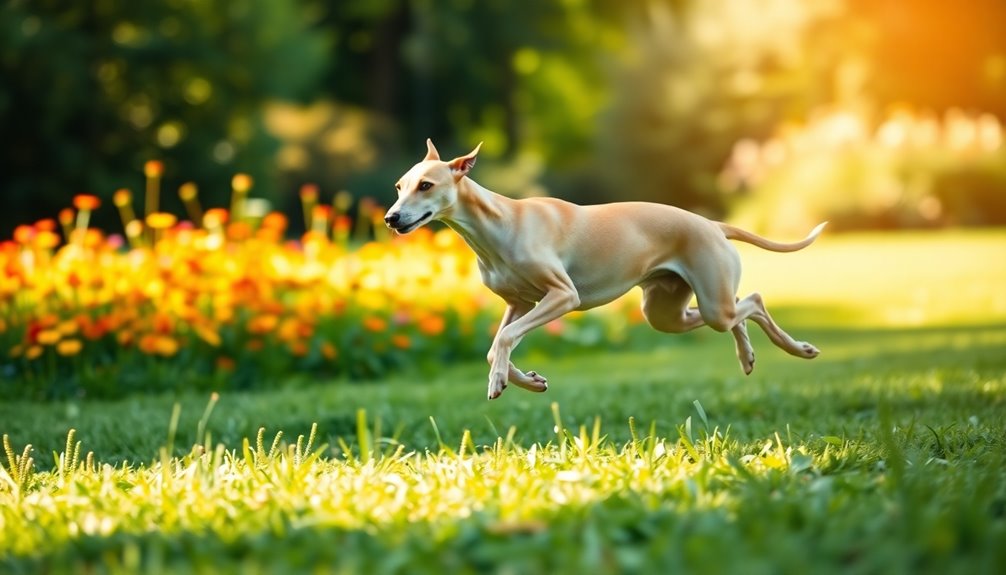
If you lead an active lifestyle, the Italian Greyhound can be a great fit, but they also make gentle companions for seniors.
Their grooming needs are minimal, making them easy to care for, yet they do require attention to their sensitivity, especially in colder weather. These dogs are known for their high-stepping, free gait, which makes them a joy to watch during exercise.
Balancing their exercise with care ensures a happy, healthy relationship for both you and your Italian Greyhound.
Gentle Companions for Seniors
Italian Greyhounds make wonderful companions for seniors, blending affection with a gentle demeanor. Their loyal and sociable nature means they thrive on close interaction with you, providing a warm and comforting presence.
These dogs are known for being quiet; they don't bark excessively, making them ideal for apartment living or quieter homes.
While they do need 45 minutes to an hour of exercise daily, their adaptable nature allows for shorter, manageable walks or play sessions. As long as you can commit to regular physical activity, you'll find they fit well into your routine. Additionally, incorporating shorter exercise sessions can be beneficial for seniors, further enhancing your bond.
However, be mindful that they can become destructive if under-exercised, so keeping them engaged is key.
Italian Greyhounds benefit from early socialization, helping them become confident companions. With a little patience and consistent training, they respond well to positive reinforcement.
Their gentle temperament makes them suitable for seniors who enjoy a bit of activity but don't lead overly busy lifestyles. If you love spending time outdoors, these sleek dogs will happily join you, making them the perfect addition to your life.
Grooming Needs and Sensitivity
While you enjoy an active lifestyle, grooming your Italian Greyhound is straightforward and manageable.
Start with daily check-ups by running your hands over their body to spot any lumps or unusual signs. Don't forget to inspect their eyes, mouth, ears, and paws for any issues. Regular check-ups can enhance your dog's overall health and well-being.
For dental care, brush their teeth daily with a canine toothbrush and toothpaste, and consider using seaweed supplements to prevent plaque. A daily mouth wipe with a cotton bud and Chlorhexidine Solution can help maintain gum health.
When it comes to nail maintenance, trim their nails weekly or fortnightly to prevent discomfort and complications. Use quality clippers or an electric nail filing tool, and consider an anti-slip bath mat to keep them steady during trimming.
For bathing, you only need to do it once a month. A warm damp cloth or dog wipes often suffice between baths. Use a gentle dog shampoo, and always follow up with a conditioner to keep their coat healthy. Additionally, because these dogs are often referred to as "velcro dogs", they thrive on close companionship, making regular grooming a bonding experience.
With these simple grooming tasks, your Italian Greyhound will stay clean and comfortable, allowing you both to enjoy your active lifestyle together.
Frequently Asked Questions
Do Italian Greyhounds Shed a Lot?
No, Italian Greyhounds don't shed a lot. Their short, fine coat means they shed minimally throughout the year, making them a low-shedding breed.
You mightn't even notice the shedding in your home. Daily brushing helps keep their coat healthy and removes any loose hair, while a monthly bath keeps them clean.
This breed's low shedding makes them a great choice if you're concerned about dog hair around your living space.
Can Italian Greyhounds Be Left Alone for Long Periods?
You shouldn't leave Italian Greyhounds alone for long periods, ideally no more than 4 to 5 hours.
Their strong attachment to you makes them prone to separation anxiety.
To help, start training with short absences and gradually increase the time.
Make sure they're exercised beforehand, and provide distractions like toys to keep them occupied.
Are Italian Greyhounds Good With Children?
Yes, Italian Greyhounds can be good with children, especially in calm environments.
Their small size makes them suitable for families, but you need to supervise interactions closely.
These dogs are sensitive and can get overwhelmed by loud noises, so gentle handling is essential.
Teach your kids to interact quietly and respectfully to prevent accidents.
Early socialization and consistent training will help ensure a happy relationship between your Italian Greyhound and your children.
What Is the Best Diet for an Italian Greyhound?
To keep your Italian Greyhound healthy, focus on a high-protein diet featuring quality sources like beef, chicken, and fish.
Incorporate essential fatty acids and small amounts of carbohydrates from veggies and berries.
Feed them two meals daily, adjusting portions based on their age and activity level.
Consider grain-free options if they're sensitive, and always ensure their meals are balanced.
Hydration's vital, so provide plenty of fresh water alongside their food.
How Often Should I Groom My Italian Greyhound?
You should groom your Italian Greyhound regularly to keep its coat healthy and clean.
Brush it once a week to remove excess hair and manage shedding, especially during Spring and Autumn.
Bathe your dog once a month using a moisturizing shampoo and conditioner.
Don't forget daily check-ups for skin, ears, and teeth to catch any issues early.
Regular grooming will help ensure your pet stays comfortable and looking great!
Conclusion
In conclusion, the Italian Greyhound is a sleek and elegant companion that perfectly fits into an active lifestyle. With their graceful movements and affectionate nature, these dogs bring joy and energy to your home. Their need for exercise and socialization makes them ideal for those who love being outdoors. If you're ready for a loyal friend who thrives on companionship and activity, the Italian Greyhound could be the perfect addition to your life.

